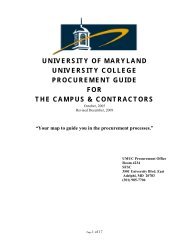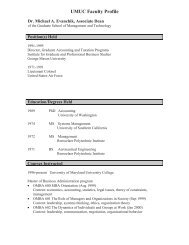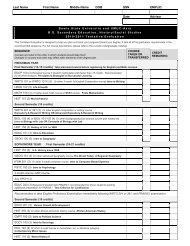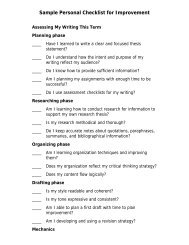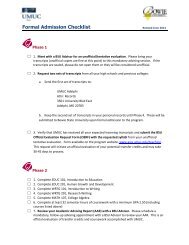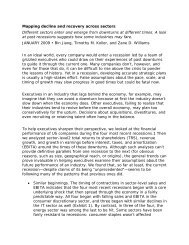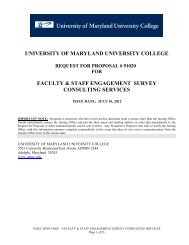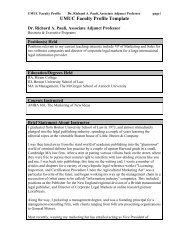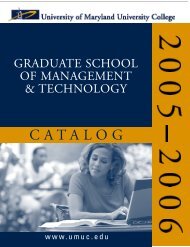UMUC's Procedures for Reporting Suspected Child Abuse and ...
UMUC's Procedures for Reporting Suspected Child Abuse and ...
UMUC's Procedures for Reporting Suspected Child Abuse and ...
You also want an ePaper? Increase the reach of your titles
YUMPU automatically turns print PDFs into web optimized ePapers that Google loves.
University of Maryl<strong>and</strong> University College<strong>Reporting</strong> <strong>Procedures</strong> <strong>for</strong> <strong>Suspected</strong> <strong>Child</strong> <strong>Abuse</strong> <strong>and</strong> NeglectAs a member of the University of Maryl<strong>and</strong> University College campus community, you must makea report under requirements of State law if you ever suspect that child abuse or neglect hasoccurred. These State law requirements are rigorous <strong>and</strong> they apply whenever you have reason tobelieve that a current or past incident of child abuse or neglect has occurred.These procedures are intended to assist in implementing the University System of Maryl<strong>and</strong>’sPolicy on the <strong>Reporting</strong> of <strong>Suspected</strong> <strong>Child</strong> <strong>Abuse</strong> <strong>and</strong> Neglect (VI—1.50), which provides direction<strong>and</strong> guidance on how Maryl<strong>and</strong>’s m<strong>and</strong>atory child maltreatment reporting laws apply in theinstitution setting.The policy may be found at: http://www.usmd.edu/regents/bylaws/SectionVI/In addition, the University of Maryl<strong>and</strong> University College website has other useful guidance <strong>and</strong>web links regarding the specific reporting requirements that apply to you, as well as the legaldefinitions of child abuse <strong>and</strong> neglect, indicators of different <strong>for</strong>ms of child maltreatment, USMreporting <strong>for</strong>ms, Frequently Asked Questions <strong>and</strong> other in<strong>for</strong>mation that will help you meet yourresponsibilities under the law <strong>and</strong> the USM policy.1. Determining Whether You Need to Make a ReportUnder Maryl<strong>and</strong> law, you must report if you have “reason to believe that a child hasbeensubjected to abuse or neglect”, Maryl<strong>and</strong> Annotated Code, Family Law Article, Section 5-704(a) <strong>and</strong> 5-705(a). In some instances, you may witness an incident or receivein<strong>for</strong>mation that obviously will require a report. In other situations, the need to make areport may not be clear, especially when the in<strong>for</strong>mation that you have is vague orsubstantially incomplete. In these cases, consider the following:A. Would reporting the in<strong>for</strong>mation provide <strong>Child</strong> Protective Services (CPS) or the policewith enough in<strong>for</strong>mation to initiate an investigation of possible incident? Essentialin<strong>for</strong>mation includes:i. Sufficient in<strong>for</strong>mation to identify <strong>and</strong> contact the victim; <strong>and</strong>ii. In<strong>for</strong>mation that will allow <strong>Child</strong> Protective Services (CPS) or the police todetermine whether the incident constituted child abuse or neglect under the law,including:a. Whether the victim was a child (i.e., under age 18) when the incident occurred;b.Whether the alleged perpetrator was a parent, household or family member, orother person who had care, custody or supervision of the child when themaltreatment occurred;1
c. Whether the child was injured, harmed or at substantial risk of harm as a resultof the alleged maltreatment.B. In the absence of this in<strong>for</strong>mation, you are not required to report the incident, but youstill should consider making a report if you genuinely suspect that it was child abuse orneglect.i. The decision to make a report is appropriate, <strong>and</strong> protected under the law <strong>and</strong> thepolicy, as long as it is made in good faith.ii. <strong>Child</strong> Protective Services (CPS) encourages individuals, who have any genuinesuspicion that child abuse or neglect may have occurred, to report it.C. If you have any concerns or doubts as to whether to report an incident, feel free todirect any questions to <strong>Child</strong> Protective Services (CPS) or to consult with RobynSeabrook, Assistant Vice President <strong>for</strong> Institutional Resolution <strong>and</strong> Accessibility, Designee<strong>for</strong> the reporting of child abuse or neglect, in the Office of the President, AdministrationBuilding 2316, 301-985-7177. Also the “Frequently Asked Questions about <strong>Reporting</strong><strong>Suspected</strong> <strong>Child</strong> <strong>Abuse</strong> in the USM” on our website may provide you with helpfulguidance.2. Making a ReportA. Call the <strong>Child</strong> Protective Services (CPS) Hotline or the police in the locality where thesuspected abuse or neglect took place as soon as possible.i. A link to local <strong>Child</strong> Protective Services <strong>Reporting</strong> Hotline Numbers appears on theCPS website at: http://www.dhr.state.md.us/cps/address.phpii. You can report to the police by calling 911.iii. If you are unsure of the location where the suspected maltreatment occurred, callCPS or the Prince George’s County police.Always call 911 immediately if you witness child abuse or neglect actually taking place.B. After making a report to <strong>Child</strong> Protective Services (CPS), also promptly in<strong>for</strong>m RobynSeabrook , UMUC Designee to receive reports of suspected child abuse <strong>and</strong> neglect, if:i. You are a professional employee of the institution <strong>and</strong> you learn of themaltreatment in the course of your duties at the institution; orii. The abuse or neglect involves:a. A USM employee, contractor, volunteer or student;b. An incident on institution property; orc. An incident that took place in connection with an institution-sponsored orrecognized program or activity.2
3. Submitting a Written ReportIf you are a professional employee who makes a report in the course of your work duties,you must follow up your oral report with a written report within 48 hours of when yoususpected that an incident of abuse or neglect occurred.A. Please use the USM Form “University System of Maryl<strong>and</strong> Report of <strong>Suspected</strong> <strong>Child</strong><strong>Abuse</strong> or Neglect” <strong>for</strong> reporting child abuse/neglect, which appears at.B. Although only USM professional employees are required to submit a written report,other individuals are encouraged to complete <strong>and</strong> submit the <strong>for</strong>m if they suspect childabuse or neglect.C. This <strong>for</strong>m should be sent to <strong>Child</strong> Protective Services (CPS) <strong>and</strong> the local state’s attorney,<strong>and</strong>, if appropriate, under Section 2.B to UMUC Designee.D. Every ef<strong>for</strong>t should be made by those making a report to protect the privacy of the child,the child’s family <strong>and</strong> the in<strong>for</strong>mation exchanged. Reports should be sent in a sealedenvelope marked “confidential.”4. Necessary In<strong>for</strong>mationA. Reports should include all of the following in<strong>for</strong>mation, to the extent that it is known, bythe individual reporting:i. the name, age, address <strong>and</strong> whereabouts of the child;ii. the name <strong>and</strong> address of the child’s parents or other caregiver;iii. the nature <strong>and</strong> extent of the suspected maltreatment;iv. any other in<strong>for</strong>mation that may help in identifying the abuser or neglector ordetermine the cause.B. The reporter is only required to report in<strong>for</strong>mation that is either witnessed by you,disclosed to you, or which you have learned as part of your regular professionalresponsibilities (e.g., a health care practitioner’s review of medical reports or records).i. You are not expected or encouraged to interview the child or conduct anyindependent inquiry into the incident or disclosure that led to the belief thatabuse or neglect has occurred. Reporters should not initiate their owninvestigation of the alleged maltreatment.ii. In some cases, you will not have sufficient in<strong>for</strong>mation to complete the <strong>for</strong>m.Simply report the in<strong>for</strong>mation that you have <strong>and</strong> leave the other items blank.C. While you are personally responsible <strong>for</strong> reporting suspected child maltreatment,duplicative reporting is not required under the law or USM policy in these situations:i. If you are a USM employee or student working at a location off-campus wherethe law requires that you report suspected abuse or neglect to the head of that3
ii.iii.facility (e.g., a teaching intern assigned to a public school), you are only requiredto report the suspected maltreatment to <strong>Child</strong> Protective Services (CPS) <strong>and</strong> thehead of that facility, not to UMUC Designee, unless the suspected abuser orneglector is an employee, contractor or volunteer of the institution.If you <strong>and</strong> another institution colleague develop a reason to believe that childabuse or neglect has occurred in the process of your work together (e.g., asmembers of a treatment team, or through an employee/supervisor relationship),you may file a single, joint report.If a disclosure of past abuse or neglect is made in a public group setting (e.g., inclass or at a campus event), the individual(s) responsible <strong>for</strong> convening the groupor event is responsible <strong>for</strong> making the report on behalf of the other attendees.5. <strong>Reporting</strong> Follow-UpA. Depending upon the specific circumstances of the alleged child maltreatment, you maybe contacted by <strong>Child</strong> Protective Services (CPS) or the UMUC Designee <strong>for</strong> morein<strong>for</strong>mation after making a report.B. Your identity as a reporter of suspected child abuse or neglect will be kept confidentialby both <strong>Child</strong> Protective Services (CPS) <strong>and</strong> the institution.C. Maryl<strong>and</strong> law <strong>and</strong> USM policy offer immunity from reprisal to any member of thecampus community <strong>for</strong> making a good faith report of child maltreatment.D. Under State <strong>and</strong> Federal child abuse confidentiality laws, it is possible that you will notbe in<strong>for</strong>med of the results of the child maltreatment investigation that was initiated inresponse to your report. If you are not contacted by <strong>Child</strong> Protective Services (CPS) orUMUC Designee, please do not assume that the concern which you reported was notinvestigated or addressed.E. By following the provisions of the USM policy <strong>and</strong> these procedures in good faith, youwill have met your obligations under the law <strong>and</strong> the policy to report suspected childmaltreatment.6. Special Concerns when <strong>Reporting</strong> Past <strong>Abuse</strong> Disclosed by an Adult VictimUnder the official Attorney General’s Opinion interpreting Maryl<strong>and</strong>’s child abuse reportinglaws, http://www.oag.state.md.us/Opinions/1993/78oag189.pdf, Maryl<strong>and</strong> citizens arerequired to follow the State’s reporting requirements <strong>for</strong> suspected child abuse or neglect,even if you learn about the maltreatment <strong>for</strong> the first time from an adult victim who wasunder the age of 18 when the incident occurred. USM institutions are obligated to followthis requirement.A. The reporting requirements are the same <strong>for</strong> in<strong>for</strong>mation about past abuse. Accordingto <strong>Child</strong> Protective Services (CPS), these reports are important to “determine whetherchildren in the household or care of the alleged abuser or neglector are currently inneed of protection.” (Department of Human Resources Circular Letter SSA 95-14).4
B. In many instances of past abuse disclosed by an adult victim, the in<strong>for</strong>mation disclosedto you may be incomplete.i. Use the guidance in Section 1 of these procedures to determine whether thein<strong>for</strong>mation is sufficient to make a report.ii. Once again, it is not necessary <strong>for</strong> you to approach or interview the victim toobtain additional in<strong>for</strong>mation. Simply report the in<strong>for</strong>mation that you do haveavailable, especially any in<strong>for</strong>mation that helps CPS to determine whetherchildren currently are at risk of abuse or neglect:a. The identity <strong>and</strong> whereabouts, if known, of the alleged abuser or neglector;b. The identity <strong>and</strong> whereabouts of any children who may currently requireprotection from the alleged abuser or neglector; <strong>and</strong>c. Any other in<strong>for</strong>mation that would help to determine the nature <strong>and</strong> cause of thesuspected maltreatment <strong>and</strong> the identity of the suspected abuser/neglector.C. You are required to report the name <strong>and</strong> contact in<strong>for</strong>mation that you have regardingthe adult victim. However, if you have any reason to be concerned that the adult victimmay be distressed or will otherwise experience negative consequences as a result ofyour report:i. Make that concern clear when you make your report orally <strong>and</strong>, if required, inwriting; <strong>and</strong>ii. Consult with Robyn Seabrook, UMUC Designee.D. While it is not required that you in<strong>for</strong>m the adult victim that you are making a report,you should feel free to do so.5




